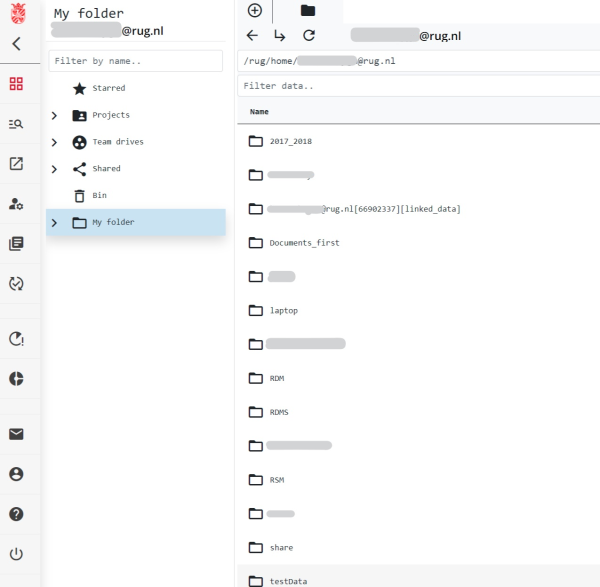This is an old revision of the document!
Storing Data
In the RDMS, data can be stored in three different environments:
- Personal Home Drive
- Team Drive
- Projects
Home Drive:
This is the default environment accessible by every user. This storage space is a personal environment only accessible to the user who owns the account. Users can decide to share folders or files with other RDMS users from this environment. Whether you log in to RDMS via the web portal, iCommands or another available client, your RDMS Home Drive always has the path: /rug/home/<username>@rug.nl.
Team Drive:
This environment can be seen as a storage space for a research group or for other collaborators to collectively store and share data. This data could include collaborative project data as well as data that is not used at the moment but could be used for potential future work. Or, a common area where all the research projects and outputs from each member (PhD, master, Postdoc, etc.), including past and current, are stored. Data storage can be secured through permission management for different group members within a Team Drive. Users can decide to share folders or files with other RDMS users from this environment. Whether you log in to RDMS via the web portal, iCommands or another available client, your RDMS Team Drives always have the path: /rug/home/<Team_Name>. Research groups can apply for a team drive in the RDMS by sending an email to rdms-support@rug.nl. For further details on how to create and use a Team Drive in the RDMS please check the Team Drives section in the wiki.
Projects:
A Projects space can be created upon request. The Projects storage space is used for storing final data from specific projects. These would include datasets from publications such as articles, posters, a book (chapter), theses, conference proceedings, and software. For example, once it is unchanging datasets from team drives can be moved to this location. Subsequently, the Projects area is the first stage where final datasets are collected before before moving to an archiving workflow once the project has completed. During this archiving stage, the data is checked by the responsible persons, enriched with metadata, and finally put as a data package in a fixed state. Currently, RDMS does not have the functionality of publishing these data packages from within the system. This user manual and the users will be updated once the publishing becomes available.
Secondly, the Projects storage area can be used for projects that require strict permission levels, for example in comparison to team drives. Moreover, upon request additional specific policies can be implemented on the data.
Whether you log in to RDMS via the web portal, iCommands or another available client, your RDMS Projects always have the path: /rug/home/Projects/<Project_Name>. For more detailed description of Projects and how to use them please check the Managing Projects section of the wiki.
<html> <center></html> Different storage environments in the RDMS seen on the dashboard of the RDMS WebApp <html> </center></html>
